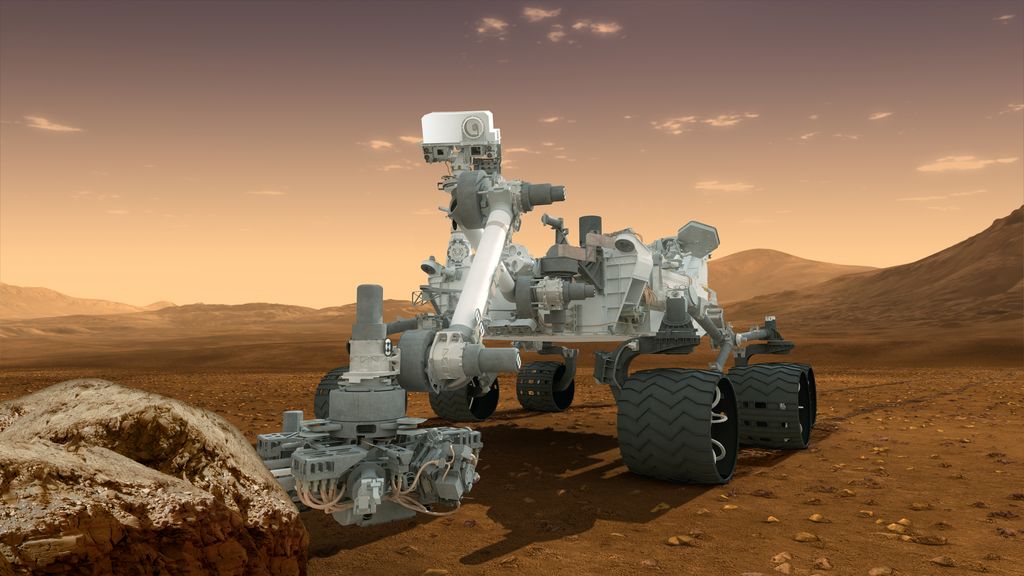This post is part of a series produced by Singularity University.
[aditude-amp id="flyingcarpet" targeting='{"env":"staging","page_type":"article","post_id":504630,"post_type":"story","post_chan":"none","tags":null,"ai":false,"category":"none","all_categories":"offbeat,","session":"A"}']After more than eight years of planning and a 254-day journey through the cold emptiness of space, NASA’s Curiosity rover has finally landed on Mars. Curiosity is the most advanced mobile robotic science lab to ever explore another planet and thus this is an exciting moment for NASA and the world.
But robotics and artificial intelligence continue to advance at an exponential rate. As we look towards the future of space exploration in the next decade and beyond, we can expect the next generation of space robots to be orders of magnitude more powerful and intelligent, while at the same time costing a fraction of Curiosity’s $2.5 billion price tag.
AI Weekly
The must-read newsletter for AI and Big Data industry written by Khari Johnson, Kyle Wiggers, and Seth Colaner.
Included with VentureBeat Insider and VentureBeat VIP memberships.
Regardless of the success of the Mars rover Curiosity, debates will rage again about robotic versus human space exploration. We don’t have the budgets to build the right technology to send humans to the planets and beyond. So we’ve been sending probes out into the solar system as precursor missions for the day we step on another planet and explore other worlds ourselves. But the bigger question for now is about the technology we are using. How do we make sure what we send in space is current? True, Curiosity is the most advanced rover ever made. The development started over eight years ago. How does it compare to recent technological advancements?
Some of the technologies Curiosity carries are similar to what a person might carry on a vacation trip to an exotic destination: several cameras with 4 GB flash cards, a 200 MHz computer, and a transportation vehicle the size of a small rental car. Like a tourist in a remote location, most days Curiosity can only send messages back home at dial-up speeds (just enough to send emails and some Twitter posts). But it does get “broadband” for 8 minutes a day to send HD images and video from Mars.
At the beginning of Curosity’s exploration of Mars, we look forward to the new images and discoveries. The rover aims to explore for a Martian year, but the nuclear power source may last for 14 years. What does the future hold for Curiosity?
I hope that today’s landing will be followed by a step that has become routine on interplanetary missions: The software on the rover will be updated. Even though spacecraft travel at high speeds through the solar system, the travel times are long enough that software advances can be significant. The software has already been updated once during its 8-month flight.
Beaming software is one way robots throughout the solar system can take advantage of exponential advances on Earth. In a few more years, the computing systems on interplanetary robots will be able to run extremely complex AI programs due to further advances in exponential technology. Perhaps advanced chips will be sent out to be fitted onto older spacecraft, and extend the life of rovers like Curiosity.
Advancement in autonomous navigation systems, such as those used by the Google Cars, and intelligent data understanding (reacting to unexpected events) are current technologies. The rise of semantic technologies (such as a future version of Watson or Siri on Mars) and machine learning will drastically change robotic missions in the near future.
[aditude-amp id="medium1" targeting='{"env":"staging","page_type":"article","post_id":504630,"post_type":"story","post_chan":"none","tags":null,"ai":false,"category":"none","all_categories":"offbeat,","session":"A"}']
Advanced software could be hosted on the next generations of Mars rovers, or even retrofitted into rovers like Curiosity. Around the time AI systems are creating the next AI systems on Earth, we may be able to beam AI programs out to robots on Mars with a complexity beyond human understanding.
When this happens, would there even be a reason to leave Earth to explore the Universe? Do we enhance our experience through the robots we send out into the cosmos with highly sophisticated exponential sensor technologies that will serve as our eyes and ears – beaming back fully immersive experiences, without traveling for years – or do we even get superseded by super-robots who could one day think for themselves?
Through radical advances in processors including quantum computing, on-board decision making and exponential learning, a robotic intelligence on Mars may eventually “wake up.” How will we know? A sign might be when we tell the rover to go a certain direction, and it disagrees, and then goes a different way based on its own interest. One day, Curiosity itself may become curious.
Emeline Paat-Dahlstrom is VP of Operations for Singularity University. She spent two decades in the private space sector working on program development and operations for companies and organizations like Space Adventures, Odyssey Moon and the International Space University. She co-authored the book Realizing Tormorrow: The Path to Private Spaceflight.
[aditude-amp id="medium2" targeting='{"env":"staging","page_type":"article","post_id":504630,"post_type":"story","post_chan":"none","tags":null,"ai":false,"category":"none","all_categories":"offbeat,","session":"A"}']
Photo credit: NASA/JPL-Caltech
VentureBeat's mission is to be a digital town square for technical decision-makers to gain knowledge about transformative enterprise technology and transact. Learn More

